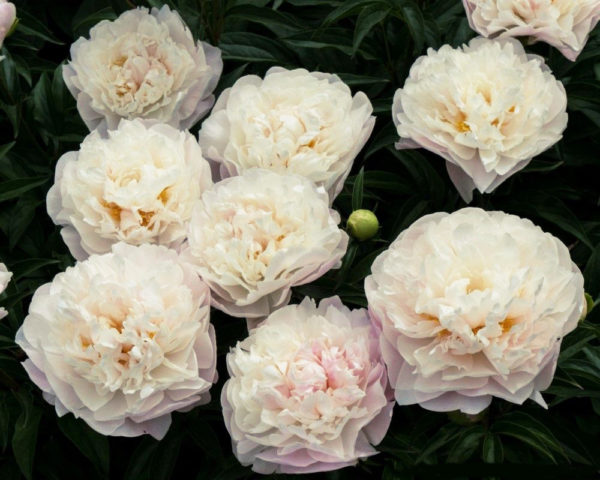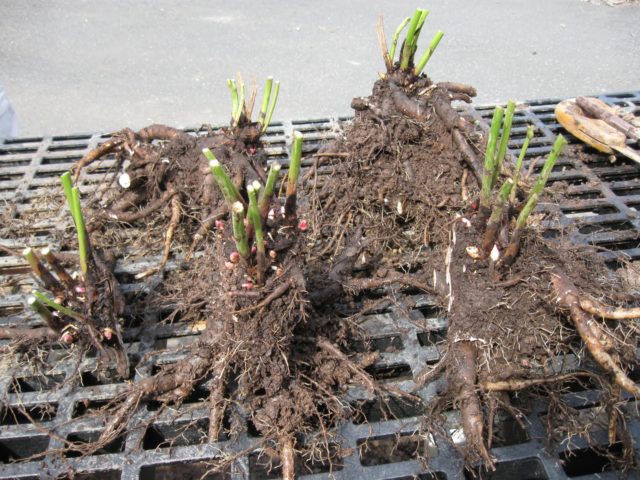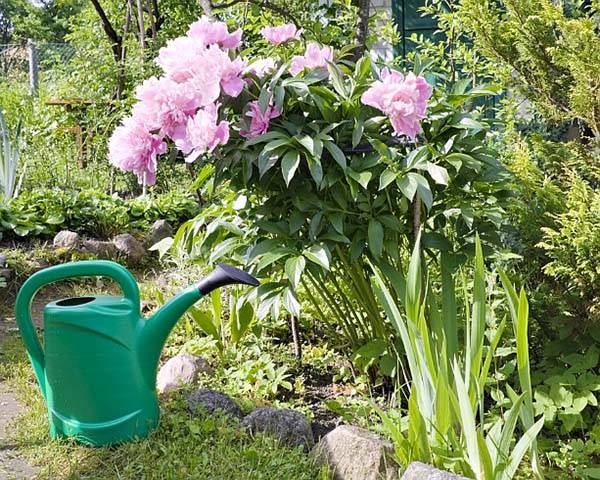Content
It is believed that the beauty of the flower peonies can compete only with the rose. Anyone who has seen these beautiful plants bloom will agree with this statement. Today, many different varieties are grown on gardeners' plots - both new and old, for example, Madame Kalot's peony has been pleasing its owners with its flowering for more than 150 years. Experienced growers know why this variety is attractive and how to grow it correctly.
Description of peony Madame Calot
The Madame Calot variety was bred in France in 1856. It grows quickly, the bush is compact, 75-100 cm high, the leaves are green, and a reddish tint appears by autumn. The stems are strong, during the flowering period they do not lean to the ground, so the bush does not need support.
Plants of this variety like to grow in a sunny place, but they also thrive in partial shade. The soil is preferred fertile, not acidic, well-drained. Winter hardiness of the Madame Calot variety is high, it can withstand temperatures up to -37 ˚С. It can be planted in almost all regions of Russia, except for the most northern ones. In one place without a transplant, it can bloom for 15-20 years.

Blooming peonies of the Madame Calot variety will not leave anyone indifferent
Flowering features
Peony lacto-flowered Madame Kalot blooms in late May, early June. Long-lasting and abundant flowering. The flower in plants of the variety is 14 cm in diameter, double, crown, with a strong aroma. The petals are creamy white, with a pale pink tint around the edges and pink closer to the center of the flower. In the process of flowering, the color of peonies may lighten. They look great both on a bush in the garden and in a cut.
Application in design
The peony is a large plant with large, noticeable flowers that looks best in the garden by itself, rather than surrounded by other flowers. When planting in a group, he needs to pick up neighbors that will bloom a little earlier or later. It is desirable that these are also perennials and after flowering they remain decorative, like the peony itself, with its beautiful green leaves.
For example, for early spring flowering next to Madame Calot's peonies, you can plant crocuses, tulips, daffodils, irises, hyacinths, primroses, honeysuckle will look good from bushes. After the peonies, delphiniums, lilies, bells, poppies, petunias, foxgloves and asters will bloom. From non-flowering, but ornamental plants next to a peony, conifers can be planted - juniper, thuja, pine.
Madame Kahlo's peony is large and not intended for growing in pots, where it will be cramped, and with irregular feeding, it will lack nutrients. If you grow it not in the garden, but, for example, on the balcony, then you need to choose a sufficiently voluminous container so that the flower growing in it does not need anything. It will have to be looked after more carefully, fed every year and watered more often.

Peonies look good in the garden in combination with other flowers.
Reproduction methods
Peonies of the Madame Calot variety are propagated by dividing the bush or by rooting cuttings - stem and root. The first method is propagated at the end of summer or in September, when the growth of stems and leaves has already stopped, renewal buds have formed, but new roots have not yet begun to grow. It is this period that is considered the most appropriate time, since the plant is already dormant. It can be divided in early spring, but still, the period before the start of regrowth of young roots in spring is shorter, so it is more difficult to guess over time when the transplant will not harm the plant.
How to transplant Madame Kalot's peony by dividing the bush:
- Cut off the stems at a height of 0.2 m, remove the leaves.
- Dig in a bush, lift a clod of earth along with the roots.
- Shake off the ground from the rhizome.
- Divide it into parts, each should have at least 2-5 buds.
- Sprinkle the sections with ash or coal powder.
You don't have to dig up the whole plant, but dig it up on one side, cut off a part of the rhizome suitable for transplanting, and then sprinkle it with earth again.
Root cuttings are a part of the root at least 10 cm long. They are not planted in a permanent place, but in a special bed, where young roots and growth buds appear on them. Peonies grown from root cuttings bloom for 3-5 years of life.
Green cuttings are part of the stem with a root collar. They are grown in the same way as root ones, that is, they are first rooted in a warm and humid place, and then transplanted to a permanent one.

It is important to divide the cuttings of peonies correctly so that the plant takes root
Landing rules
Peony seedlings Madame Calot with open roots should be bought in early spring or early autumn. Potted plants can be planted in spring and summer. The spring planting time must be chosen so that the temperature is not higher than 7-10 ° C. The success of further rooting depends on this: the plant grows white roots at a temperature not exceeding the indicated one. If it is warmer, it will not have time to root properly, but the stems will begin to grow, consuming rhizome reserves. This will oppress the plant, it will become sick and develop worse.
In the fall, the planting of Madame Calot's peonies should take place no later than a month before the deadlines when the cold weather sets in. For reliability, they can be piled up or covered with mulch to protect them from damage.
For peonies, you need to choose open, sunny places or partial shade, but do not place them under trees or close to buildings and fences, where they will be strongly stretched. Winds should not walk on the site so that during flowering they do not scatter the stems in all directions. Too damp areas, acidic soils are not suitable. Peonies prefer loam and clay, they bloom more magnificently and colorfully on them. On sandy soils, flowering is not so decorative, although it begins earlier.
If Madame Kalot's peony seedlings are healthy, they do not require special preparation. But it is recommended to keep their roots in a solution of growth stimulants for 1 day before planting. After planting is complete, you can water the plants with the same solution.
At the bottom you need to lay out a drainage layer of brick chips, broken slate, small stones. Top up with a mixture of dug earth, humus or compost, ash. To deepen the seedlings so that the buds are covered with earth by about 3 cm. Lightly tamp the soil, pour water over it. If the soil begins to sag, you need to add it so that the buds are covered.
Follow-up care
Madame Kahlo's milk-flowered peonies adapt well to different weather conditions, but, like all garden flowers, require care. Water them often after planting until they take root. Adult bushes are hardly watered, only in summer in case of strong or prolonged heat.
For the first 2 years, Madame Calotte's peonies do not feed, they have enough of those nutrients that were fertilized during planting.
Then every year the plants are fed according to the scheme:
- In the spring, during the growth of the stems - nitrogen fertilizers (50-70 g per bush).
- During the period of throwing out the buds, phosphorus and potassium mixtures are added to the nitrogen ones (diluted according to the instructions). For 1 bush, approximately 0.5-1 bucket of solution is required.
- After the end of flowering, potassium-phosphorus fertilizers are used, without nitrogen.
For feeding Madame Calot peonies, both mineral fertilizers and organic matter are suitable.
In the first year, peonies should not bloom: the plants have not yet matured, they will spend nutrients for flowering, which can greatly weaken them.
Despite the resistance, during the flowering period in rain or wind, the stems can lean to the ground. They need to be tied together with a rope. After the flowers begin to wilt, they are cut to prevent seed formation and reduce the likelihood of fungal diseases.

Peony care should be correct, and feeding on schedule
Preparing for winter
In the fall, when cleaning the garden, you need to cut off all the shoots at ground level, collect them and burn them. Sprinkle young bushes with a layer of mulch.
Pests and diseases
Most often, peonies are infected with gray rot. The causes of the disease are wet weather, poor ventilation of the bushes due to close proximity to each other, excess nitrogen. Control measures: cut off the affected parts of the stems and burn them, spray the shoots, leaves and soil around with a solution of copper sulfate (50 g per bucket) or solutions of copper-containing preparations.
Conclusion
Although the Madame Calot peony has been bred for a long time, it is still popular with flower growers. Their devotion to this variety can be explained by the exceptional beauty of the flower, the unpretentiousness and durability of the plant.
Peony Madame Calot reviews








